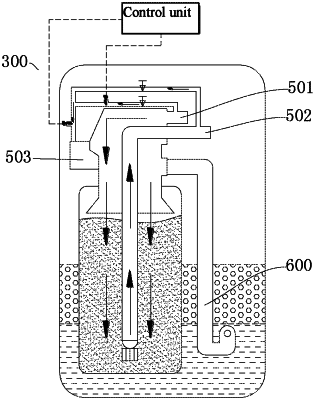| CPC G01N 33/1853 (2013.01) [G01N 27/07 (2013.01); G01N 27/10 (2013.01)] | 11 Claims |

|
1. A sensor comprising:
a water hardness detection probe comprising a first probe and a second probe, and used for measuring a potential difference between the first probe and the second probe; wherein each of the first probe and the second probe comprises a base part and a coating layer, the coating layer is deposited on all surfaces of the base part, the base part is made of titanium, and the coating layer is made of ruthenium oxide-iridium oxide, lead oxide or tin oxide;
a raw water pipe, wherein a first valve is located on the raw water pipe, and the first probe is connected to the raw water pipe and disposed between the first valve and an outlet of the raw water pipe;
a softened water pipe, wherein a second valve is located on the softened water pipe,
a converging pipe, communicating with the raw water pipe and the softened water pipe respectively, wherein the second probe is disposed on the converging pipe; and
a controller, comprising a processor and a potential detector configured to measure a potential between the first probe and the second probe, wherein the controller connects to the first valve and the second valve respectively;
wherein during detecting water hardness of softened water, the first probe is configured to being located in raw water and the second probe is configured to being located in the raw water firstly and then being transferred into the softened water; when the first probe and the second robe are both located in the raw water a first potential value obtained b the potential detector is regarded as a first potential, and when the first probe is located in the raw water and the second probe is located in the softened water, a second potential value obtained by the potential detector is regarded as a second potential; and the processor is configured to determine the water hardness of the softened water according to a potential difference between the first potential and the second potential.
|
|
8. A water hardness detection method by using the sensor of claim 1, comprising:
opening the first valve, closing the second valve, injecting raw water into the raw water pipe, locating both the first probe and the second probe in the raw water, and measuring the first potential between the first probe and the second probe;
opening the second valve, closing the first valve, injecting softened water into the softened water pipe, locating the first probe in the raw water, locating the second probe in the softened water, and measuring the second potential between the first probe and the second probe; and
determining, by the processor, the water hardness of the softened water according to the potential difference between the first potential and the second potential.
|